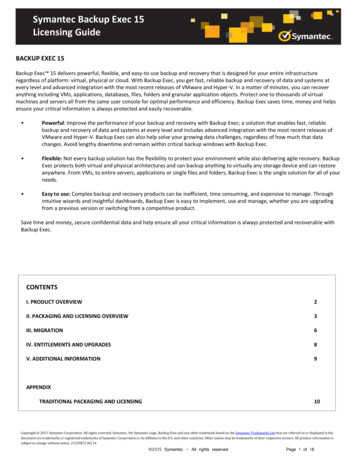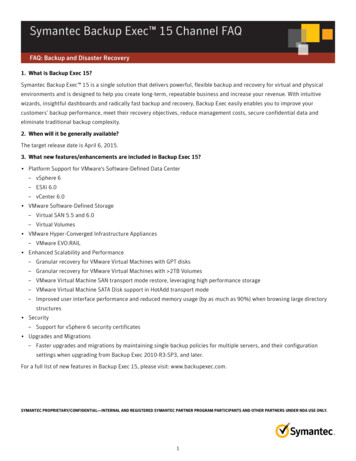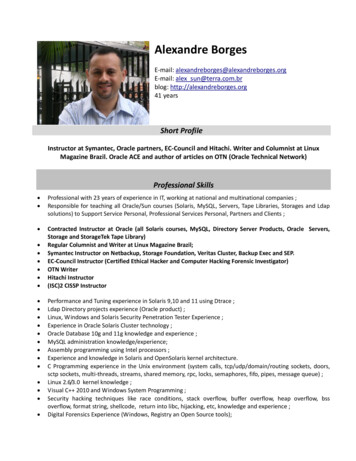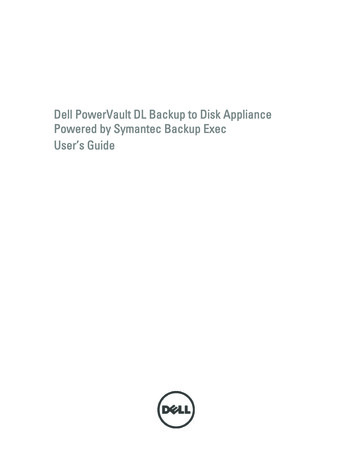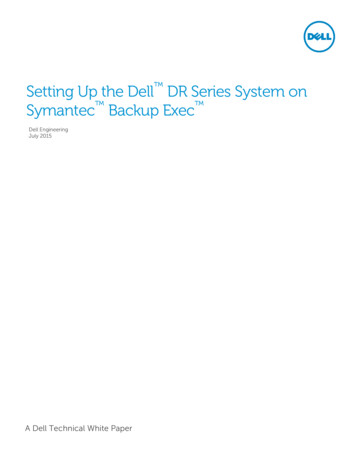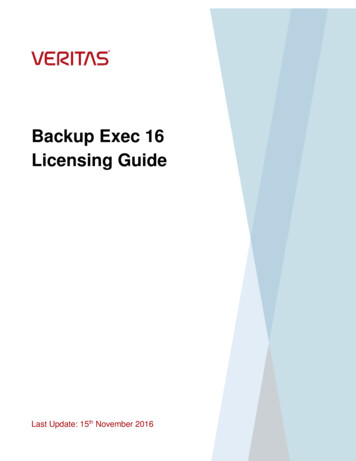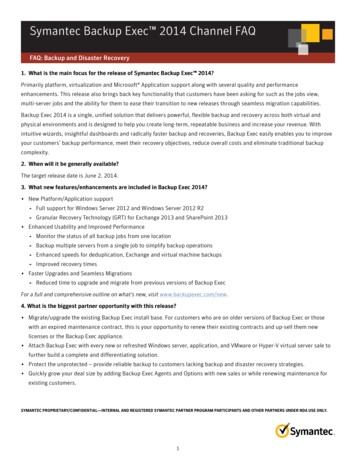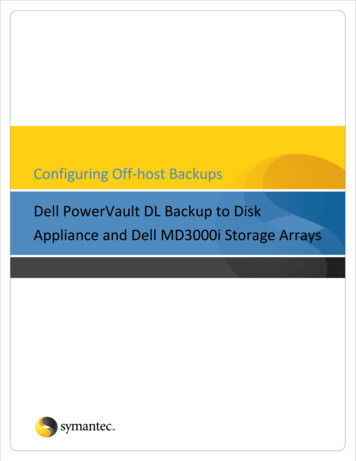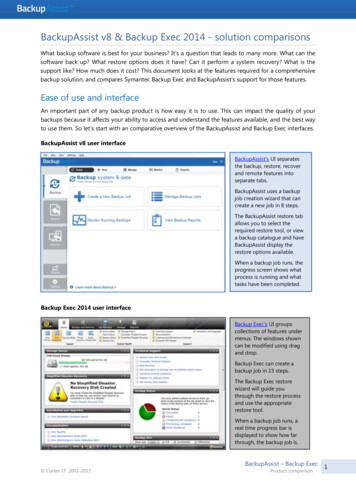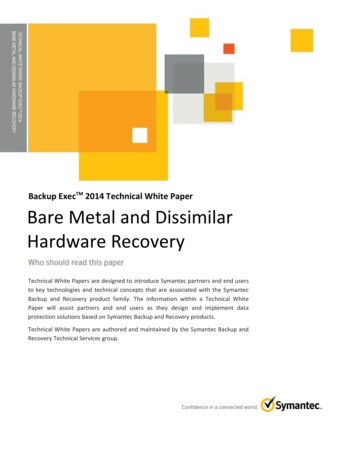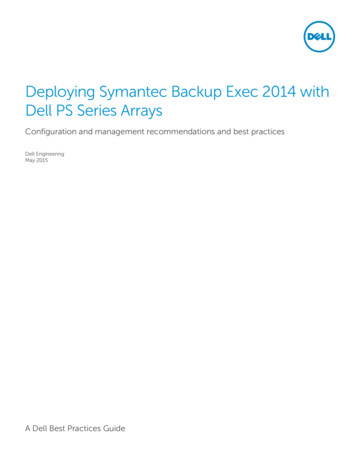
Transcription
Deploying Symantec Backup Exec 2014 withDell PS Series ArraysConfiguration and management recommendations and best practicesDell EngineeringMay 2015A Dell Best Practices Guide
RevisionsReportDateDescription1.0January 2011Initial release2.0May 2015Updated with support for Backup Exec 2014AcknowledgementsAuthored by: Daniel J. CurranTHIS WHITE PAPER IS FOR INFORMATIONAL PURPOSES ONLY, AND MAY CONTAIN TYPOGRAPHICAL ERRORS AND TECHNICAL INACCURACIES.THE CONTENT IS PROVIDED AS IS, WITHOUT EXPRESS OR IMPLIED WARRANTIES OF ANY KIND. 2011 - 2015 Dell Inc. All rights reserved. Dell, the DELL logo, and the DELL badge are trademarks of Dell Inc. Other trademarks and trade namesmay be used in this document to refer to either the entities claiming the marks and names or their products. Dell disclaims any proprietary interestin the marks and names of others.2Deploying Symantec Backup Exec 2014 with Dell PS Series Arrays TR1057
Table of contentsRevisions . 2Acknowledgements . 2Preface . 5Audience . 51Introduction to Symantec Backup Exec 2014 and PS Series storage . 62Common backup and recovery configurations . 82.1VSS snapshots and backup . 103Exchange backup levels . 144SharePoint backup levels. 155Symantec application agents, and ADBO . 165.1Deploying Symantec Backup Exec 2014 . 165.2Basic steps . 165.3PS Series group requirements . 185.4Backup server requirements . 185.5Backup client requirements . 226Launching the Backup Administration Console . 237Creating disk backup media . 248Creating an off-host backup job for NTFS volume(s) . 299Creating an off-host backup job for Microsoft Exchange 2013 . 3610 Creating a VSS backup job for Microsoft SharePoint 2013 . 4211 Restoring NTFS files from an offhost backup . 4612 Restoring Microsoft Exchange 2013 from an offhost backup .4813 Restoring Microsoft SharePoint data from a VSS backup . 5114 Summary . 553AConfiguration details . 56BCreating a volume in a PS Series group . 57B.1Configuring CHAP. 62B.2Host Integration Tools for Microsoft . 63B.3Perform a manual installation of HIT for Microsoft . 64B.4Configuring PS Series group access in ASM/ME . 64B.5Connecting to a PS Series volume from Windows . 66Deploying Symantec Backup Exec 2014 with Dell PS Series Arrays TR1057
B.6C4Making a PS Series volume available to Windows.68Additional resources. 73C.1Technical support and customer service . 73C.2Dell online services . 73C.3Dell PS Series storage solutions . 73C.4Related documentation . 74Deploying Symantec Backup Exec 2014 with Dell PS Series Arrays TR1057
PrefaceDell PS Series arrays optimize resources by automating performance and network load balancing.Additionally, PS Series arrays offer all-inclusive array management software, host software, and firmwareupdates at no additional cost.AudienceThe information in this guide is intended for technology professionals interested in using Dell PS Seriesstorage in a Microsoft Windows environment. It is also intended for administrators that have or will bedeploying Symantec Backup Exec 2014 and are interested in using the VSS and offhost function withDell PS Series storage.To learn more about Dell PS Series products and new releases being planned, visit Dell TechCenter w/wiki/2660.equallogic-technical-content. This siteprovides articles, demos, online discussions, technical documentation, and more details about the benefitsof the PS Series product family.An updated list of SAN components that have been tested by Dell is available in the Dell StorageCompatibility Matrix.Current customers: You may not be running the latest versions of the tools and software listed above. Ifyou are under valid warranty or support agreements for your PS Series array, you are entitled to obtainthe latest updates and new releases as they become available.5Deploying Symantec Backup Exec 2014 with Dell PS Series Arrays TR1057
1Introduction to Symantec Backup Exec 2014 and PS SeriesstorageThis document describes how to use Symantec Backup Exec 2014 for Windows Server with Dell PS Seriesstorage arrays to back up and restore NTFS volumes, Microsoft Exchange email, and MicrosoftSharePoint data. The procedures use Microsoft Volume Shadow Copy Service (VSS), the Dell HostIntegration Tools (HIT) kit for Microsoft, and Symantec Backup Exec 2014 to create point-in-time copiesof data called shadow copies or snapshots.Note: The HIT kit installs and configures several components, including the Remote Setup Wizard, VSSand VDS Provider Services.This report shows how to use the same products to offload backup and restore operations from theremote host with transportable snapshots. Moving the backup from the remote host to the backup (media)host increases backup performance and reduces backup windows while freeing remote host resources.Note: PS Series arrays can be used with traditional VSS (non-offhost) backup operations and require nospecial configuration.Symantec Backup Exec 2014 for Windows Server provides comprehensive data protection for Windows,and supports the following features: Support for VSS and hardware-based snapshotsAdvanced Open File Option (AOFO)Advanced Disk-based Backup Option (ADBO)Deduplication OptionAutomated data lifecycle management for disk-based storageGranular Recovery Technology (GRT) for Exchange 2013 and SharePoint 2013Integration with Microsoft Hyper-V and VMware vSphere , including physical-to-virtualconversionsPS Series storage arrays are designed to deliver the benefits of consolidated storage in an intelligent iSCSIstorage area network (SAN) that provides highly-available and scalable storage to backup and recoveryservers and clients running Symantec Backup Exec. The iSCSI SAN, called a PS Series group, consists ofone or more arrays connected to an IP network. As your storage needs grow, simply add more arrays tothe group; capacity and performance increase linearly and on demand.6Deploying Symantec Backup Exec 2014 with Dell PS Series Arrays TR1057
Key features for a PS Series SAN include: Easy setupRedundant, hot-swappable hardwareHighly scalable, virtualized storageIntegrated, self-managing softwareAutomatic RAID configuration and managementHigh-end features like snapshots and replicationAuto-Stat Disk Monitoring SystemAutomatic data and network I/O load balancingA PS Series volume is seen on the network as an iSCSI target and can be accessed by an iSCSI initiatorinstalled on a host. This storage can play two roles in backup operations: Store the application data that will be backed up.For example, you can create volumes to store Exchange databases. Act as backup media (instead of tape) for storing the backed up data.For example, you can create volumes to store the backup of an Exchange database.With the HIT kit installed, a PS Series SAN can also: Serve as a VSS provider to Windows Serve as a VDS provider to Windows Support Microsoft Multipath I/O7Deploying Symantec Backup Exec 2014 with Dell PS Series Arrays TR1057
2Common backup and recovery configurationsSymantec Backup Exec 2014 can be used in a variety of backup and recovery configurations, includingLAN backup and recovery, SAN backup and recovery, backup and recovery media, backup to disk andrestore from disk operations, and backup to tape and restore from tape operations.LAN backup and recovery: A centralized backup server (Backup Exec server) runs the backup software andbacks up other servers (backup clients) by using software agents. The data movement is over a LAN.SAN backup and recovery: A centralized backup server (Backup Exec server) runs the backup software andbacks up other servers (backup clients) by using software agents. The data movement is over a SAN.Although PS Series storage arrays can be used in a LAN backup and recovery configuration, the more likelyconfiguration is to use a PS Series SAN with Symantec Backup Exec 2014. Backing up using a SAN canimprove backup performance because all data movement is through the SAN. In addition, technologiessuch as backup-to-disk and VSS off-host are best implemented using a SAN.This Technical Report focuses on the SAN backup and recovery configuration in Figure 1. In the SANconfiguration described in this Technical Report, the backup server (Backup Exec server) runs the backupsoftware and schedules, and it runs the backup jobs. The backup clients run backup agent softwareresiding on the servers that run the applications (for example, Exchange, SharePoint or host file systems)that you want to back up. In some cases, the backup server can also act as a backup client when backingup its own data. All backed up data resides on a PS Series group including the disk backup media forstoring the backed up data.Figure 18SAN backup and recovery configurationDeploying Symantec Backup Exec 2014 with Dell PS Series Arrays TR1057
Backup and recovery media: Backup media refers to the device that stores backed up data. Backup mediacan be fixed, such as disk, or removable, such as tape. Symantec Backup Exec 2014 supports backup totape, as well as backup to disk, and PS Series arrays are ideally suited for disk backup media.Traditionally, tape has been the backup media of choice, because tapes can be easily transported to aseparate facility for storage, and retrieved in the event of a disaster. However, disk backup media isbecoming more commonplace because it improves backup performance, provides online recoverycapabilities, and supports the use of advanced operations such as snapshot-based backups.Backup to disk and restore from disk operations: In a backup to disk scenario, not only is the data backedup and stored in a volume on a PS Series group, another volume on a PS Series group serves as the backupmedia to enable disk-based backups. This document describes how use the Backup Exec StorageProvisioning Option (SPO) to configure a virtual disk mapped to a PS Series volume; a quick way to createbackup media on a PS Series group.Environments using Windows Server and the HIT kit can use the Microsoft Volume Shadow Copy Service(VSS) to create snapshots of application data that is used as the source of a backup.It is important that when performing virtual disk backups that a copy of data is stored away from primarydata. This can be accomplished by maintaining tape backups stored at a remote location, or by replicatingdata to a remote location.Backup to tape and restore from tape operations: Data stored in a PS Series volume can be backed upusing any of the traditional disk-to-tape (D2T) backup methods. Simply follow the Symantec Backup Execrecommended procedures for your environment.You can also backup to tape using VSS, by following the instructions in the backup-to-disk sections of thisreport and selecting tape for the backup device (backup media).9Deploying Symantec Backup Exec 2014 with Dell PS Series Arrays TR1057
2.1VSS snapshots and backupSnapshots (also called shadow copies) are point-in-time copies of data. A snapshot enables you to quicklycopy data at the disk volume level. This volume copy can then be used as the source for backupoperations. Snapshot creation does not disrupt access to the volume. The copy is created, typically in afew seconds, and maintained in disk storage (for example, in a PS Series group), providing highperformance and low space utilization.When using snapshots to backup data, the snapshot capability must be integrated with the backupapplication, the applications and file systems to be backed up, and the storage devices. Historically, thisintegration has required using custom scripts, which are difficult to create and maintain for properoperation over time. These requirements have severely restricted the adoption of snapshot-basedbackups.Microsoft has a technology in Windows Server called Volume Shadow Copy Service (VSS). VSS provides aframework for creating snapshots that integrates VSS-aware disk storage (for example, PS Series arrays),applications (for example, Exchange or SharePoint), and operating system drivers, delivering a turn-keybackup solution to IT departments without the need for scripting.There are three required components in the VSS framework as illustrated in Figure 2.VSS writer (1): A business application (such as a database application, e-mail, or file system) that preparesthe application for snapshot creation or data restoration (for example, by flushing buffers, switching logs,etc.). Hyper-V, NTFS, Exchange, SharePoint, and SQL are examples of VSS writers.VSS requestor (2): Requests the creation of snapshots, typically for backup operations. Symantec BackupExec 2014 supports VSS and can be used as a VSS requestor.VSS provider (3): The mechanism that actually creates and maintains the snapshot in the storagehardware. For example, the HIT kit installs a VSS provider that can create snapshots in a PS Series group.10Deploying Symantec Backup Exec 2014 with Dell PS Series Arrays TR1057
Figure 2VSS framework1.VSS writer integrated with the application, which prepares the application for the backup orrestore operation.2. VSS requestor is usually a backup application that requests the creation of shadow copies andprovides an interface for backing up and restoring data. Backup Exec functions as a requestor.3. VSS provider is installed with HIT for Microsoft and interacts directly with the PS Series group.This illustrates how to use the HIT kit for Windows (VSS provider) with Symantec Backup Exec 2014 (VSSrequester) to backup and restore Hyper-V, NTFS, Exchange, SQL, and SharePoint applications (VSS writers)providing an end-to-end backup and restore solution.A snapshot provides a stable copy of volume data for backups. There are three types of VSS snapshots:Local software-based, Local hardware-based and Transportable (offhost) hardware-based.Local software-based VSS snapshots: The backup application is responsible for creating and storing thesnapshot of a backup client volume. Then, the backup client mounts the snapshot, and the backup serverbacks up the snapshot.11Deploying Symantec Backup Exec 2014 with Dell PS Series Arrays TR1057
Local hardware-based VSS snapshots: The backup application requests that the storage hardware createand store the snapshot of a backup client volume. Then, the backup client mounts the snapshot, and thebackup server backs up the snapshot.Local snapshot operations typically work as shown in Figure 3.Figure 3Local snapshot operations.1.The backup application either creates and stores a snapshot of the backup client volume, or itrequests that the storage hardware (PS Series group) creates and stores the snapshot.2. The backup client mounts the snapshot and the backup server backs up the snapshot.3. The snapshot may be deleted after the backup is complete.12Deploying Symantec Backup Exec 2014 with Dell PS Series Arrays TR1057
Transportable (offhost) hardware-based VSS snapshots: The backup application requests that the storagehardware create and store the snapshot of a backup client’s volume. Then, the backup server mounts thesnapshot and backs up the snapshot. This moves (offloads) backup processing from the backup client andmoves it to the backup server (offhost).Transportable (offhost) snapshot operations typically work as shown in Figure 4.Figure 4VSS Transportable snapshot operations1.The backup application requests that the storage hardware (PS Series group) create and store asnapshot of the backup client volume.2. The backup server mounts and backs up the snapshot.3. The snapshot may be deleted after the backup is complete.13Deploying Symantec Backup Exec 2014 with Dell PS Series Arrays TR1057
3Exchange backup levelsSymantec Backup Exec 2014 supports many levels of backup for Microsoft Exchange 2010 and 2013. Twoof the basics are: Individual databases network backup / database availability groups (DAG) network backup. Snapshot and offhost backups of DAG or individual database(s). The backup software gives you theoption of backing up each Exchange mailbox database or complete Information Store to backupmedia.Note: Each backup level has its advantages and disadvantages. This report focuses on leveraging the VSScapabilities of Symantec Backup Exec 2014 with ADBO, using the offhost function in backing up theExchange Information Store and NTFS files.14Deploying Symantec Backup Exec 2014 with Dell PS Series Arrays TR1057
4SharePoint backup levelsSymantec Backup Exec 2014 supports many levels of backup for Microsoft SharePoint 2010 and 2013. Afew of these are: Web applications and their associated databasesSites and subsites. Individual objects and their versions can be restored from full database backupsIndividual documents and any pictures that are contained in librariesConfiguration databases that contain all of the configuration information for the entire SharePointServer farm. Use caution when you restore this database. Any changes that you make to the farmtopology before you restore from the backup are lost. The configuration database can be restoredonly to its original location.Note: Each backup level has its advantages and disadvantages. This report focuses on leveraging the VSScapabilities of Symantec Backup Exec 2014 with GRT and enabled farm-level backups.15Deploying Symantec Backup Exec 2014 with Dell PS Series Arrays TR1057
5Symantec application agents, and ADBOBackup Exec 2014 includes agents for backing up a number of database applications, including MicrosoftExchange, and SharePoint/SQL Server.For transportable snapshots, Backup Exec 2014 supports the Advanced Disk-based Backup Option(ADBO). ADBO allows offhost backup using PS Series arrays with Backup Exec 2014 for Windows Serverson the Backup Exec server (also known as the backup server) that is doing the backup.If you plan to back up Exchange or SharePoint/SQL Server using VSS, the relevant agents must be installedon the Backup Exec server that is doing the backup, along with having a current version of the Agent forWindows on the application server.For more information on ADBO or the application agents, see the Symantec Backup Exec 2014Administrator’s Guide.5.1Deploying Symantec Backup Exec 2014The following sections describe how to backup and restore NTFS volumes, Exchange e-mail, andSharePoint farm items using Symantec Backup Exec 2014, a PS Series group, and the HIT kit.The procedures focus on the use of VSS and transportable snapshots. However, traditional backup andrecovery methods and vendor-specific backup techniques that do not support transportable snapshotscan also be used to back up the data residing on PS Series volumes.See the Backup Exec 2014 documentation for application installation and configuration details. See thePS Series QuickStart or Group Administration manual for information about setting up a group andvolumes. See the Auto-Snapshot Manager Installation and Administration manual for detailedrequirements and installation information. Also, appendix B has PS Series storage and Host IntegrationTools step-by-step instructions.5.2Basic stepsThis section provides an overview of the basic steps for backup and recovery operations using a PS SeriesiSCSI SAN. Refer to the specified sections for detailed information.1.Set up the PS Series group and create the following volumes:- Backup client volumes that will contain the application data to be backed up for eachvolume, create one or more access control records that allow the backup client access tothe volumes. Be sure to reserve snapshot space for each client volume. In addition, for eachvolume, create one or more access control records that allow the backup server snapshotonly access to the volumes.- One or more backup volumes for the disk backup media for each volume, create one ormore access control records that allow the backup server access to the volumes.16Deploying Symantec Backup Exec 2014 with Dell PS Series Arrays TR1057
See PS Series group requirements in this document for more information.If your SAN is composed of multiple PS Series arrays, consider creating multiple pools of storageand segregating application data storage from backup data storage. See the PS Series FirmwareGroup Administration manual for more information.For more information on Dell Host Integration Tools for Microsoft, please refer to the DellEqualLogic Host Integration Tools/Microsoft Edition - Installation and User's Guide – Version 4.7.1and the Dell EqualLogic Host Integration Tools for Microsoft Windows – Release Notes – Version4.7.1 at eqlsupport.dell.com (requires login).Log in, or click Create Account to request a new support account.Properly configure the SAN network for best performance. See the document, Windows Server2012 NIC Optimization and Best Practices with EqualLogic SAN, for more information.2. Ensure that the backup server (Backup Exec server) and backup clients (remote servers) meet therequirements described in “Backup server requirements" in this document.a.On the backup server, install Windows Server 2012 or later along with the required hot fixesand service packs, and an iSCSI initiator if required. You can use an available hardware iSCSIinitiator, or the OS software initiator. Use the HIT kit to install Remote Setup Wizard, VSS andVDS Provider Services on the backup server, configure the server to detect storage grouptargets, and install the PS Series MPIO Device Specific Module.Configure one or more virtual disks for disk backup media. Optionally, you can create astorage device pool for disk backup media. Create persistent connections to the backupvolumes for the disk backup media. Initialize the volumes, align disk sectors, and format thenew disks. Ensure that the backup server can access the VSS control volume. Then install theSymantec Backup Exec software and the Symantec application-specific agents.On each backup client, install Windows Server 2012 or later, the required hot fixes and servicepacks. Persistently connect to the backup client volumes. Also from the Backup Server createpersistent snapshot-only connections to the volumes to be backed up (allows Backup Execserver access to application volumes).b. Initialize the volumes, and format the new disks. Install the HIT kit on the backup client. Ensurethat the backup client can access the VSS control volume. Install the applications (for example,SharePoint or Exchange) and configure the applications to use the new disks.3. Perform these tasks on the backup server:a. Launch the Symantec Backup Exec Administration Console.b. Create one or more virtual disks for disk backup media. Optionally, you can create storagedevice pools for disk backup media.c. Install the Symantec Backup Exec Remote Agent for Windows Servers from the backup serverto any clients where you will back up NTFS volumes or application data.17Deploying Symantec Backup Exec 2014 with Dell PS Series Arrays TR1057
5.3PS Series group requirementsPS Series group requirements are as follows: One or more backup client volumes that will contain the data to be backed upBe sure to reserve snapshot space for each volume. For each backup client volume, create one ormore access control records to allow the backup client access to the volume. If you will becreating transportable snapshots, you must also create one or more access control records toallow the backup server snapshot-only access to these volumes.Before creating volumes, be sure to fully understand the individual application requirements (forexample, e-mail, database, or file system), so you can allocate a sufficient amount of storage space toeach volume. Note that volumes can be expanded easily online. One or more backup volumes for the disk backup media. (Not required if you are only backing up totape.) The volume size depends on the frequency and amount of data to be backed up. /Also, for each backup volume, create one or more access control records that will allow thebackup server access to the volume. VSS control volume. The Host Integration Tools for Windows automatically creates this volume.Note: Dell PS Series Storage and Host tools step by step instructions are in appendix B.See the PS Series Quick Start or the Group Administration manual for information about creating a group,volumes, and access control records.See the Host Integration Tools for Microsoft Windows User Guide and Release Notes manual forinstallation information and additional requirements.In addition, it is recommended that you consult the Network Connection and Performance Guidelines oneqlsupport.dell.com (requires login) for information about how to improve network performance whenusing a PS Series SAN.5.4Backup server requirementsThere are two types of servers involved in backup and recovery operations: Backup server and Backupclient.Backup server (Symantec uses the term Backup Exec server): The backup server schedules, catalogs, andruns the backup and restore jobs.Backup client (Symantec uses the term remote server): A backup client hosts the file system andapplication data (for example, NTFS file system or Exchange or SharePoint data) that you want to back upand, through software age
Symantec Backup Exec 2014 supports backup to tape, as well as backup to disk, and PS Series arrays are ideally suited for disk backup media. Traditionally, tape has been the backup medi
